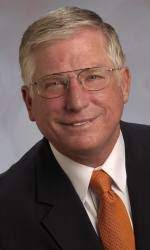Ray Mears stopped coaching in the 1970s but his career winning percentage of 74.7% still ranks among the best in NCAA history. He played basketball at Miami University and was later inducted into the school’s Athletics Hall of Fame. As a coach at Wittenberg University he won the NCAA College Division Basketball Tournament in 1961, then moved to Tennessee where he won 3 SEC titles and was 2-time SEC COY. HoopsHD’s Jon Teitel got to chat with former Tennessee SID Bud Ford about “Big Orange Country” and the Bernie & Ernie Show. Mears passed away in 2007 but today would have been his 95th birthday so we take this time to celebrate his life/legacy.
Mears played college basketball at Miami (OH) as a walk-on: how did he get into coaching? He was coaching at Wittenberg and had just won a national title when Tennessee was looking for a head coach. He was hired here to build up a program that had not been successful in several years.
He became coach at Wittenberg in 1957 and led the Tigers to 4 conference titles in 6 seasons as well as a 4-PT win over SE Missouri State in the 1961 D-2 title game: what did it mean to him to win a title? He was a very innovative coach: some of the things that he was doing in terms of promotions were ahead of his time. He did a lot of public speaking and created a booster group to promote the game. He created a holiday tournament and had our team warm up to “Sweet Georgia Brown” while using an orange and white basketball. He wanted everyone in Knoxville to come and watch the game so it helped that not all of our games were on TV. We would have made a bunch of NCAA tourneys but for the fact that Kentucky was the only SEC who kept making it because they always won the conference.
He became head coach at Tennessee in 1962: why did he take the job? He had been in junior college and wanted to coach on the D-1 level at a school that had a chance to compete against teams like Kentucky and coaches like Adolph Rupp. He was able to motivate his team to play the Wildcats: we even won several games on the road.
He was known for wearing his trademark orange blazer during games: how did he come up with the concept of “Big Orange Country”? Our arena originally had a capacity under 10,000 people, but after enlarging the arena he brought in the marching band to walk all around the floor while playing the fight song. 1 time we even had a local weightlifter wrestle a bear! We had an “Orange Tie Club” whose members all wore orange ties to games.
In the 1967 NCAA tourney Ron Widby scored 20 PTS but his shot in the final seconds rimmed out in a 1-PT loss to Dayton: did you think the shot was going in? I did not attend the game but I thought it was going in as I was listening to the game on the radio. Dayton had a really good team featuring Don May.
In the 1977 NCAA tourney Bernard King/Ernie Grunfeld each had a double-double before fouling out in a 5-PT OT loss to Syracuse: where does that rank among the most devastating losses of his career? Those 2 players each averaged 25 PPG in our run-and-gun offense. The enthusiasm for those players helped us move to a bigger arena. Syracuse had a rookie coach at the time named Jim Boeheim. I think that our most disappointing loss was to VMI in the 1976 NCAA tourney: King missed that game due to a sprained thumb. Coach Mears like the challenge of playing good teams so we traveled to a lot of good tourneys around the country.
He was a 2-time SEC COY: what did it mean to him to receive such outstanding honors? He was certainly a driven person. I hoped that we could get him into the Hall of Fame: his health issues cut his career a little short but he was still 1 of the great coaches of his era.
His career record of 399-135 still ranks among the best winning percentages in NCAA history and he never had a losing season in 21 years on the sideline: what made him such a great coach? He played a controlled offense and a 1-3-1 defense. He was also great at recruiting local players who were great athletes like Widby. He had an intensity for detail about him. He had an offensive efficiency rating system to calculate how many points you were scoring per possession: we were always tops in the nation with 1.5 or 1.6. We also were great at defensive FG% and seldom allowed opponents to shoot 50 FG% against us. We also had a great FT% and had great ball-handlers who would get fouled because there was no shot-clock back then. He believed that certain people did certain things: shooters would shoot and defenders would guard the ball.
After retiring as a coach he spent 10 years as athletic director at Tennessee-Martin: why did he take the new gig, and how did he like it compared to coaching? He did a great job at Martin: his health was what really forced him to stop coaching. He later returned to Knoxville and came to all our games. To this day every coach that followed him will wear an orange blazer when we play Kentucky or Vanderbilt as a tribute to Coach Mears.
He passed away in 2007: when people look back on his career, how do you think he should be remembered the most? There is no question that he will be remembered as a promoter but also as a very good tactician/coach. He was intense and tried to make his teams ready to play so that they were into the game.




